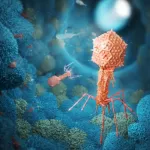(Press-News.org) Coherence stands as a pillar of effective communication, whether it is in writing, speaking or information processing. This principle extends to quantum bits, or qubits, the building blocks of quantum computing. A quantum computer could one day tackle previously insurmountable challenges in climate prediction, material design, drug discovery and more.
A team led by the U.S. Department of Energy’s (DOE) Argonne National Laboratory has achieved a major milestone toward future quantum computing. They have extended the coherence time for their novel type of qubit to an impressive 0.1 milliseconds — nearly a thousand times better than the previous record.
“Rather than 10 to 100 operations over the coherence times of conventional electron charge qubits, our qubits can perform 10,000 with very high precision and speed.” — Dafei Jin, professor at the University of Notre Dame with a joint appointment at Argonne’s Center for Nanoscale Materials.
In everyday life, 0.1 milliseconds is as fleeting as a blink of an eye. However, in the quantum world, it represents a long enough window for a qubit to perform many thousands of operations.
Unlike classical bits, qubits seemingly can exist in both states, 0 and 1. For any working qubit, maintaining this mixed state for a sufficiently long coherence time is imperative. The challenge is to safeguard the qubit against the constant barrage of disruptive noise from the surrounding environment.
The team’s qubits encode quantum information in the electron’s motional (charge) states. Because of that, they are called charge qubits.
“Among various existing qubits, electron charge qubits are especially attractive because of their simplicity in fabrication and operation, as well as compatibility with existing infrastructures for classical computers,” said Dafei Jin, a professor at the University of Notre Dame with a joint appointment at Argonne and the lead investigator of the project. “This simplicity should translate into low cost in building and running large-scale quantum computers.”
Jin is a former staff scientist at the Center for Nanoscale Materials (CNM), a DOE Office of Science user facility at Argonne. While there, he led the discovery of their new type of qubit, reported last year.
The team’s qubit is a single electron trapped on an ultraclean solid-neon surface in a vacuum. The neon is important because it resists disturbance from the surrounding environment. Neon is one of a handful of elements that do not react with other elements. The neon platform keeps the electron qubit protected and inherently guarantees a long coherence time.
“Thanks to the small footprint of single electrons on solid neon, qubits made with them are more compact and promising for scaling up to multiple linked qubits,” said Xu Han, an assistant scientist in CNM with a joint appointment at the Pritzker School of Molecular Engineering at the University of Chicago. “These attributes, along with coherence time, make our electron qubit exceptionally compelling.”
Following continued experimental optimization, the team not only improved the quality of the neon surface but also significantly reduced disruptive signals. As reported in Nature Physics, their work paid off with a coherence time of 0.1 milliseconds. That is about a thousand-fold increase from the initial 0.1 microseconds.
“The long lifetime of our electron qubit allows us to control and read out the single qubit states with very high fidelity,” said Xinhao Li, a postdoctoral appointee at Argonne and the co-first author of the paper. This time is well above the requirements for quantum computing.
“Rather than 10 to 100 operations over the coherence times of conventional electron charge qubits, our qubits can perform 10,000 with very high precision and speed,” Jin said.
Yet another important attribute of a qubit is its scalability to link with many other qubits. The team achieved a significant milestone by showing that two-electron qubits can couple to the same superconducting circuit such that information can be transferred between them through the circuit. This marks a pivotal stride toward two-qubit entanglement, a critical aspect of quantum computing.
The team has not yet fully optimized their electron qubit and will continue to work on extending the coherence time even further as well as entangling two or more qubits.
The work was funded by the DOE Office of Basic Energy Sciences; a Laboratory Directed Research and Development award from Argonne; and Q-NEXT, a DOE Energy National Quantum Information Science Research Center headquartered at Argonne. Additional funding came from the Julian Schwinger Foundation for Physics Research and National Science Foundation.
This research was published in Nature Physics. In addition to Jin, Han and Li, Argonne contributors include postdocs Xianjing Zhou and Qianfan Chen. Other contributors include co-corresponding author David I. Schuster, a former physics professor at the University of Chicago now at Stanford University, and Xufeng Zhang, a former staff scientist at CNM and now a professor at Northeastern University. Also listed as authors are Gerwin Koolstra, Ge Yang, Brennan Dizdar, Yizhong Huang and Christopher S. Wang.
The collaborating institutions include Lawrence Berkeley National Laboratory, Massachusetts Institute of Technology, Northeastern University, Stanford University, the University of Chicago and the University of Notre Dame.
About Argonne’s Center for Nanoscale Materials
The Center for Nanoscale Materials is one of the five DOE Nanoscale Science Research Centers, premier national user facilities for interdisciplinary research at the nanoscale supported by the DOE Office of Science. Together the NSRCs comprise a suite of complementary facilities that provide researchers with state-of-the-art capabilities to fabricate, process, characterize and model nanoscale materials, and constitute the largest infrastructure investment of the National Nanotechnology Initiative. The NSRCs are located at DOE’s Argonne, Brookhaven, Lawrence Berkeley, Oak Ridge, Sandia and Los Alamos National Laboratories. For more information about the DOE NSRCs, please visit https://science.osti.gov/User-Facilities/User-Facilities-at-a-Glance.
Argonne National Laboratory seeks solutions to pressing national problems in science and technology. The nation’s first national laboratory, Argonne conducts leading-edge basic and applied scientific research in virtually every scientific discipline. Argonne researchers work closely with researchers from hundreds of companies, universities, and federal, state and municipal agencies to help them solve their specific problems, advance America’s scientific leadership and prepare the nation for a better future. With employees from more than 60 nations, Argonne is managed by UChicago Argonne, LLC for the U.S. Department of Energy’s Office of Science.
The U.S. Department of Energy’s Office of Science is the single largest supporter of basic research in the physical sciences in the United States and is working to address some of the most pressing challenges of our time. For more information, visit https://energy.gov/science.
END
Major milestone achieved in new quantum computing architecture
Breakthrough realized for retaining quantum information in a single-electron quantum bit
2023-10-26
ELSE PRESS RELEASES FROM THIS DATE:
"Recognition of human right to the environment can galvanize action and collaboration towards realization of sustainable development goals," eminent environmental lawyer says
2023-10-26
Amsterdam, October 26, 2023 – "The Human Right to the Environment affirms the right to life itself. When humans protect nature, they are also securing human health and wellbeing." An article by eminent environmental lawyer Prof. Nicholas A. Robinson sees the recognition of the Human Right to the Environment (HRE) as a first step in a long process of restoring a healthy environment for people and the planet.
Professor Robinson’s article is published in a special issue of the Journal of Environmental Policy and Law on The Human Right to Sustainable Environment. In the preface Editor-in-Chief Bharat H. Desai, PhD, Jawaharlal Nehru University, Centre ...
New tool measures food security duration, severity
2023-10-26
ITHACA, N.Y. – Researchers from the Charles H. Dyson School of Applied Economics and Management have developed a new method for measuring food insecurity, which for millions of people in the U.S. is more than just an abstract concept.
The group’s probability of food security (PFS) measures the likelihood that a household’s food expenditures equal or exceed the minimum cost of a healthful diet. The researchers then put the PFS to the test, analyzing food security dynamics over a recent 17-year period, and found that a third of U.S. households experienced at least temporary food insecurity.
Seungmin Lee, a doctoral student in the field of applied economics and management, ...
Excess fluoride linked to cognitive impairment in children
2023-10-26
Long-term consumption of water with fluoride levels far above established drinking water standards may be linked to cognitive impairments in children, according to a new pilot study from Tulane University.
The study, published in the journal Neurotoxicology and Teratology, was conducted in rural Ethiopia where farming communities use wells with varying levels of naturally occurring fluoride ranging from 0.4 to 15.5 mg/L. The World Health Organization recommends fluoride levels below 1.5 mg/L.
Researchers ...
Scientists find two ways that hurricanes rapidly intensify
2023-10-26
Contacts:
David Hosansky, UCAR/NCAR Manager of Media Relations
hosansky@ucar.edu
720-470-2073
Audrey Merket, UCAR/NCAR Science Writer and Public Information Officer
amerket@ucar.edu
303-497-8293
Hurricanes that rapidly intensify for mysterious reasons pose a particularly frightening threat to those in harm’s way. Forecasters have struggled for many years to understand why a seemingly commonplace tropical depression or tropical storm sometimes blows up into a major hurricane, packing catastrophic winds and driving a potentially deadly surge of water ...
Is red meat intake linked to inflammation?
2023-10-26
Inflammation is a risk factor for many chronic diseases, including cardiovascular disease (CVD), and the impact of diet on inflammation is an area of growing scientific interest. In particular, recommendations to limit red meat consumption are often based, in part, on old studies suggesting that red meat negatively affects inflammation – yet more recent studies have not supported this.
“The role of diet, including red meat, on inflammation and disease risk has not been adequately studied, which can lead to public health recommendations that are not based on strong evidence,” said Dr. Alexis Wood, associate professor of pediatrics – ...
RIT’s Campanelli receives award for work in gravitational wave science
2023-10-26
Rochester Institute of Technology distinguished professor and founding director of the Center for Computational Relativity and Gravitation Manuela Campanelli has been honored with the American Physical Society’s (APS) 2024 Richard A. Isaacson Award in Gravitational-Wave Science for her extraordinary contributions to and leadership in the understanding and simulation of merging binaries of compact objects in strong-field gravity.
The annual honor is granted to esteemed scientists for their remarkable achievements in the fields of gravitational-wave physics, gravitational wave astrophysics, and associated ...
Fruit, nectar, bugs and blood: How bat teeth and jaws evolved for a diverse dinnertime
2023-10-26
Link to full release with images:
https://www.washington.edu/news/2023/10/26/bat-teeth/
(Note: researcher contact information at the end)
They don’t know it, but Darwin’s finches changed the world. These closely related species — native to the Galapagos Islands — each sport a uniquely shaped beak that matches their preferred diet. Studying these birds helped Charles Darwin develop the theory of evolution by natural selection.
A group of bats has a similar — ...
Mobile stroke units increase odds of averting stroke
2023-10-26
Receiving a clot-busting drug in an ambulance-based mobile stroke unit (MSU) increases the likelihood of averting strokes and complete recovery compared with standard hospital emergency care, according to researchers at Weill Cornell Medicine, NewYork-Presbyterian, UTHealth Houston, Memorial Hermann-Texas Medical Center and five other medical centers across the United States.
The study, published online in the Annals of Neurology on Oct. 6, determined that MSU care was associated with both increased odds of averting stroke compared with hospital emergency medical service (EMS) – ...
Why are so many migrant families still separated? Chaos in the data
2023-10-26
U.S. government reached a settlement with thousands of families separated under the zero-tolerance policy
Experts highlight ‘mountain of a challenge’ that U.S. Family Reunification Task Force has had in accounting for separations
Task force reuniting families is working within a limited scope of separated families
‘If using DNA data to reunite families could help even one child, it’s worth giving it a shot,’ says researcher
CHICAGO --- Five years since the retraction of the Trump-era zero-tolerance policy on illegal border crossings, which resulted in the separation ...
Mammalian cells may consume bacteria-killing viruses to promote cellular health
2023-10-26
Bacteriophages, also called phages, are viruses that infect and kill bacteria, their natural hosts. But from a macromolecular viewpoint, phages can be viewed as nutritionally enriched packets of nucleotides wrapped in an amino acid shell. A study published October 26th in the open access journal PLOS Biology by Jeremy J. Barr at Monash University, Victoria, Australia, and colleagues suggests that mammalian cells internalize phages as a resource to promote cellular growth and survival.
Phage interactions with bacteria are well known, and interactions between bacteria and their mammalian host can lead ...
LAST 30 PRESS RELEASES:
New expert guidance urges caution before surgery for patients with treatment-resistant constipation
Solar hydrogen can now be produced efficiently without the scarce metal platinum
Sleeping in on weekends may help boost teens’ mental health
Study: Teens use cellphones for an hour a day at school
After more than two years of war, Palestinian children are hungry, denied education and “like the living dead”
The untold story of life with Prader-Willi syndrome - according to the siblings who live it
How the parasite that ‘gave up sex’ found more hosts – and why its victory won’t last
When is it time to jump? The boiling frog problem of AI use in physics education
Twitter data reveals partisan divide in understanding why pollen season's getting worse
AI is quick but risky for updating old software
Revolutionizing biosecurity: new multi-omics framework to transform invasive species management
From ancient herb to modern medicine: new review unveils the multi-targeted healing potential of Borago officinalis
Building a global scientific community: Biological Diversity Journal announces dual recruitment of Editorial Board and Youth Editorial Board members
Microbes that break down antibiotics help protect ecosystems under drug pollution
Smart biochar that remembers pollutants offers a new way to clean water and recycle biomass
Rice genes matter more than domestication in shaping plant microbiomes
Ticking time bomb: Some farmers report as many as 70 tick encounters over a 6-month period
Turning garden and crop waste into plastics
Scientists discover ‘platypus galaxies’ in the early universe
Seeing thyroid cancer in a new light: when AI meets label-free imaging in the operating room
Neutrophil-to-lymphocyte ratio may aid risk stratification in depressive disorder
2026 Seismological Society of America Annual Meeting
AI-powered ECG analysis offers promising path for early detection of chronic obstructive pulmonary disease, says Mount Sinai researchers
GIMM uncovers flaws in lab-grown heart cells and paves the way for improved treatments
Cracking the evolutionary code of sleep
Medications could help the aging brain cope with surgery, memory impairment
Back pain linked to worse sleep years later in men over 65, according to study
CDC urges ‘shared decision-making’ on some childhood vaccines; many unclear about what that means
New research finds that an ‘equal treatment’ approach to economic opportunity advertising can backfire
Researchers create shape-shifting, self-navigating microparticles
[Press-News.org] Major milestone achieved in new quantum computing architectureBreakthrough realized for retaining quantum information in a single-electron quantum bit





